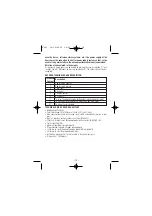
- 15 -
Note: if the system is provided with readers AF45341 (see diagram 2) and
you want the keypad code correspond to the one set on a AF45339 key,
the numbers to be inserted are the ones not covered with rubber pads; (in
the example of fig. 2: 2, 4, 6, 8, 10).
3)
Once programming is over, press the red key for 5s until when two beeps are heard;
the leds will switch on again in sequence (yellow, green+red, yellow, ecc.). if the
code has been stored correctly, led L1 of the decoder will flash slowly for 2 seconds
approx. Now the keypad code is stored in the decoder and a new code can be sto-
red, otherwise exit from the programming mode by removing jumper J2.
3a)
If the decoder led flashes quickly for 20 seconds, it means that the decoder has
detected an error: memory is full (up to a maximum of 8 codes can be stored), or
the code sent to the decoder is wrong: in this last case, programming must be
repeated;
4)
Remove programming jumper J2 from the 45378DF decoder.
User code programming
There are no differences compared to the previously described phase 3.
Keypad code deletion
There are no differences compared to the previously described section
“keypad
code deletion”
except for item 4):
4)
press the red key for 5s until when two beeps are heard; the leds will switch on again
in sequence (yellow, green+red, yellow, etc.). Now the keypad code is deleted. To
store a new code on decoder 45378DF just repeat the procedure described in “key-
pad code programming”. The new code will be stored along with the previous one,
provided that one of the eight memory cells at least, is free. Otherwise, first reset the
decoder.
Deletion of a user code
There are no differences compared to the previously described section “deletion of a
user code.
Enabling/disabling of serial decoder 45378DF
Make sure that programming jumper J2 of the decoder is not inserted.
Insert a user code: the three leds seated on the keypad will start flashing.
Then, press the red key to send the code to the decoder:
• if the code received by the decoder corresponds to a stored one, the output with the
operation desired will be enabled by means of jumper J1. To reach this jumper (J1),
which is seated immediately under led L1 (fig. 3B), remove the decoder blank plate.
Two operating modes are available:
a) J1 inserted:
monostable operation. In this mode, as soon as a recognized code
arrives, the decoder enables the output for two seconds and then it disables it.
Upon enabling the output, the device ignores all incoming codes, if any.
b) J1 not inserted:
bistable operation. In this mode, as soon as a recognized code
arrives, the decoder changes the output status: the output relay contact (NO+NC)
is changed over.
• if the code is wrong, led L1 will flash quickly for 20 seconds approx.: during this
time the decoder does not accept any code.
NOTE: if the decoder is installed on systems requiring a high level of
C421 14-10-2005 14:50 Pagina 15




































